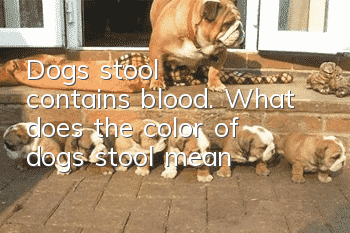Dog's stool contains blood. What does the color of dog's stool mean?

Dog poop is brown and yellow
For healthy dogs, the color of poop is usually brown or brown. This is the color that dogs normally digest and excrete, which is also a healthy color. If the color is yellowish or yellow, it may be that the food the dog eats contains high carbohydrates, such as beans, corn, rice, steamed buns, fruits, vegetables, etc. ! Normal poop does not contain any mucus or blood!
White or gray dog poop
The most common cause of this kind of poop is feeding too many bones. Poop of this color is usually divided into small pieces, dry, and crumbs when pinched. Pay attention to drinking more water and reducing the amount of bones, otherwise it will cause constipation. If bones are not fed, it is likely that stones or roundworms have blocked the bile duct, preventing biliflavin from being excreted smoothly with the stool.
Dog poop is orange-yellow
This color is unhealthy. The poop is thick and shapeless and contains orange residue. This kind of poop usually occurs in pets with loose diarrhea and poor digestion. In dogs, the symptoms are Grade 5.
Green poop in dogs
Green poop may be caused by your dog eating too much vegetables or fruits containing high chlorophyll, such as cucumber, lettuce, lettuce or celery. Caused by inability to absorb! There is also the fact that the dog has eaten some grass and things containing dyes and pigments. It may also be caused by too much acidity in the intestines.
The dog's stool is red with blood
If the dog's stool is red with mucus or blood, this is extremely abnormal. You can first check to see if it is caused by anal fissure. If not, it may be caused by lower gastrointestinal bleeding. For example, the gastrointestinal function of puppies under 3 months old is relatively fragile. Intestinal scratches may occur due to feeding dry and hard dog food and swallowing foreign objects. If the dog is listless and accompanied by fever, it is likely to be an acute gastrointestinal condition. caused by inflammation.
If a dog frequently or continuously has bloody stools or bloody stools, it may be a parasite problem. The general symptoms are jelly-like stool with blood, or white bugs in the stool, and the dog is losing weight. In addition, diseases with high fatality rates such as parvovirus, coronary disease, and pancreatitis will cause dogs to vomit and have loose stools in the early stages, and then may have diarrhea, fever, and lethargy. It is recommended to seek medical examination.
Dogs poop black
There are two situations of black poop. The first is normal and healthy. For example, the dog food that the dog eats contains more meat and the color of the dog food is darker. . The color of the stool will be darker. Of course, this kind of dog food is also expensive.
If you feed your dog food that does not contain high amounts of meat, and you have not fed it any meat, but you still poop black, this is abnormal. For example, a dog’s twelve fingersBleeding in digestive organs such as the intestines and small intestine will result in black or dark-colored stools, sometimes accompanied by intestinal mucosa!
- Is it better for Dogo dogs to have their ears erect or cropped? A case of Dogo dog’s ear erection surgery will tell you
- What do dogs eat to protect their stomach? It is important to protect their stomach and treat gastrointestinal diseases in dogs.
- How to tell if your dog is fat? Is your dog overweight?
- How to train Tibetan Mastiff Four aspects teach you how to train Tibetan Mastiff
- Will your dog catch a cold if you blow the air conditioner? What should you do if your dog catches a cold if you blow the air conditioner?
- What should you pay attention to when your dog drinks water? Don’t be careless when it comes to your dog’s drinking water.
- The dog's mouth bites and shakes. Why does the dog's mouth occasionally shake and bite?
- How to cut a dog's hair? Do you know how to cut a dog's hair correctly?
- Can dogs eat raw eggs? Why can’t dogs eat egg whites?
- Common Dog Problems in Summer How to Deal with Different Dog Problems



